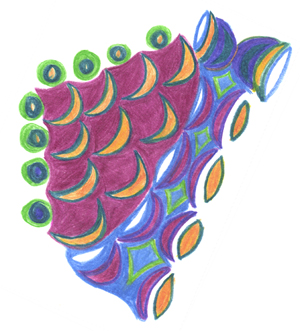
A doodle inspired by African Textiles.

A doodle inspired by African Textiles.
After a lot of not-so-happy hours of thumb-drawing (see below) I decided that, even while working on basic skills, I needed to have a bit more fun. I woke up at 5 in the morning the other day and spent an hour or so poring over old sketchbooks and thinking, yes, I could gain a lot more skills, but some of these drawings are perfect the way they are. (Examples to come later.)
The picture above is a semi-realistic portrait of the manager of a coffee shop near my home. He spends a lot of time in the back, and only comes out when he’s needed to help handle customers. So I worked on shading and such from memory until each time he popped up behind the bar. Then I’d scramble to correct what I’d done. (At one point I rotated the angle of the chin about 70 degrees counter clockwise.)
As with many of my portraits, the resemblance to the subject is highly imperfect–although the astronomer at the next table did recognize him. I’m still working my way (happily) through some ear-shape misconceptions. When I’m drawing people they’re often too far away or moving too fast for me to get much detail into the ear. Rather than trying to nail the whole ear thing down, through looking at photos or angling myself to keep my husband’s head in profile, I’ve been sharpening my conception of one anatomic structure at a time, and still pulling some of the curves from my imagination. This is all part of my trying to balance classical methods–like proper observation–with the relatively “naive” approaches I’ve been working with up to now.
I’m pleased, anyway, with the way the picture captures, and makes believable, I think, the rotational symmetry of this guy’s eyes. I feel like his youth and his unpretentiousness come across pretty well.
The astronomer, btw, had a few interesting things to say about astronomy vs. drawing–how astronomy is all about pattern recognition, but he still has trouble drawing. This challenges the adage that “drawing is seeing”–yes, but there’s also the matter of getting the hand on board.
I am writing for the sake of writing, for the sake of habit, not particularly knowing what I want to say. Same things as the last post…the need for patience. I spent a lot of time over the past couple of weeks drawing the basic objects–coffee cups, my thumbs, and being unhappy with the results. Some of the most productive time I spent was, again, drawing parallel lines, this time with pencil, trying to lay down a consistent, light shade.
I feel about art the way I remember feeling about writing as a high school student, a bit frantic, and full of potential: What IS writing? What are its parts? How do you do this?–write in such a way that satisfies readers and keep the eyes on the page? I’ve been making little drawings for the web for 9 years now and in the last 2 made some ventures into 3 space (paintings, papier-maché, collages), I finally feel the need (and the courage) to pursue basic skills.
I just signed up for one class and two workshops for the fall at the UC Berkeley ASUC Art Studio:
Introduction to Portrait Drawing
Jewelry Workshop: Basic Wire Work
Mat Cutting Workshop
On a different note, here’s a recent photo from a trip to the Botanical Garden in the parks near Niagara Falls.
I had a funky weekend of trying to draw, collage, and paint, but nothing felt quite right. Sometimes when I don’t know what to draw, I just start with drawing parallel lines as straight as I can. It’s being stuck doing a free write and scrawling out “I don’t know what to write” until something comes.
I think that the collages I’ve been doing lately have actually caused a certain amount of tension for me, as they seem more polished and striking than things I’ve done in the past–so now I want everything I make to be that exciting, which in turn leads me to be impatient with myself.
—
I spent some time last week trying to track down more information related to a brief mention, in the blurb for a 1999 exhibit on Kuba cloth, that Gustav Klimt collected African textiles. I couldn’t find a thing, not even in the journal databases accessible through the university. The man’s jacket in The Kiss looks so much to me like strip-woven cloth, such as Kente, from Western Africa, and I wonder whether he had seen any.
I did find a few notes that his companion, Emily Flöge, who with her sister ran a major fashion house, collected folk textiles (e.g., from Bohemia and Northern Hungary). Flöge and Klimt designed dresses together, as part of the the dress reform movement, which sought to free people from cruel and unusual clothing.
(Kente photo, above, right, by okrahoma, published under an Attribution-NonCommercial Creative Commons license.)